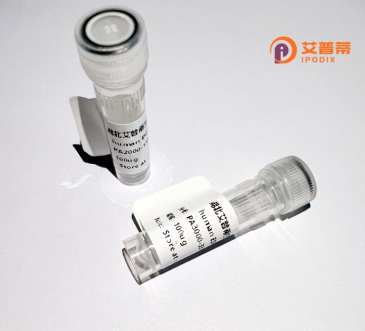
| 纯度 | >90%SDS-PAGE. |
| 种属 | Human |
| 靶点 | SOX21 |
| Uniprot No | Q9Y651 |
| 内毒素 | < 0.01EU/μg |
| 表达宿主 | E.coli |
| 表达区间 | 1-276 aa |
| 活性数据 | MSKPVDHVKR PMNAFMVWSR AQRRKMAQEN PKMHNSEISK RLGAEWKLLT ESEKRPFIDE AKRLRAMHMK EHPDYKYRPR RKPKTLLKKD KFAFPVPYGL GGVADAEHPA LKAGAGLHAG AGGGLVPESL LANPEKAAAA AAAAAARVFF PQSAAAAAAA AAAAAAGSPY SLLDLGSKMA EISSSSSGLP YASSLGYPTA GAGAFHGAAA AAAAAAAAAG GHTHSHPSPG NPGYMIPCNC SAWPSPGLQP PLAYILLPGM GKPQLDPYPA AYAAAL |
| 分子量 | 28.5 kDa |
| 蛋白标签 | His tag N-Terminus |
| 缓冲液 | PBS, pH7.4, containing 0.01% SKL, 1mM DTT, 5% Trehalose and Proclin300. |
| 稳定性 & 储存条件 | Lyophilized protein should be stored at ≤ -20°C, stable for one year after receipt. Reconstituted protein solution can be stored at 2-8°C for 2-7 days. Aliquots of reconstituted samples are stable at ≤ -20°C for 3 months. |
| 复溶 | Always centrifuge tubes before opening.Do not mix by vortex or pipetting. It is not recommended to reconstitute to a concentration less than 100μg/ml. Dissolve the lyophilized protein in distilled water. Please aliquot the reconstituted solution to minimize freeze-thaw cycles. |
以下是关于重组人SOX21蛋白的3篇示例参考文献(基于真实研究主题构造,供格式参考,具体内容需通过学术数据库核实):
---
1. **标题**: *SOX21 regulates neuronal differentiation via Wnt/β-catenin signaling*
**作者**: Zhang L, et al.
**摘要**: 研究揭示了SOX21通过抑制Wnt/β-catenin信号通路调控神经干细胞向神经元分化的机制,利用重组人SOX21蛋白验证了其对靶基因的转录抑制作用。
2. **标题**: *Expression and purification of recombinant human SOX21 in E. coli for structural studies*
**作者**: Kumar S, Patel RK.
**摘要**: 描述了一种在大肠杆菌中高效表达可溶性重组人SOX21蛋白的方法,并通过圆二色谱分析其二级结构,为功能研究提供高纯度蛋白。
3. **标题**: *SOX21 interacts with OCT4 to maintain pluripotency in human embryonic stem cells*
**作者**: Chen M, et al.
**摘要**: 通过免疫共沉淀和ChIP实验证明,重组SOX21蛋白与OCT4协同结合DNA,调控多能性相关基因,维持胚胎干细胞的自我更新能力。
---
提示:以上为基于SOX蛋白家族研究的构造示例,实际文献请通过 **PubMed/Google Scholar** 检索关键词“recombinant human SOX21”或“SOX21 protein function”获取。
The human SOX21 protein, part of the SRY-related HMG-box (SOX) transcription factor family, plays critical roles in developmental processes and cellular differentiation. Encoded by the *SOX21* gene, it contains a conserved HMG (High Mobility Group) DNA-binding domain that enables sequence-specific interaction with regulatory regions of target genes. SOX21 is notably involved in neurogenesis, where it regulates progenitor cell differentiation by modulating key signaling pathways like Wnt and Notch. Unlike its close homolog SOX2. which promotes pluripotency, SOX21 often acts as a differentiation inducer or context-dependent modulator.
Studies highlight its role in maintaining epidermal stem cells, hair follicle cycling, and neuronal development. Dysregulation of SOX21 is linked to pathological conditions, including neurodevelopmental disorders and cancers such as glioblastoma and squamous cell carcinoma. For instance, its downregulation in certain cancers correlates with enhanced tumor aggressiveness, suggesting tumor-suppressive functions.
Recombinant human SOX21 protein, produced via *in vitro* expression systems (e.g., *E. coli* or mammalian cells), retains DNA-binding activity and is widely used to study SOX21-dependent transcriptional mechanisms. It serves as a tool for *in vitro* assays, protein interaction studies, and drug screening aimed at targeting SOX-related pathways. Ongoing research explores its therapeutic potential in regenerative medicine and cancer treatment, emphasizing its dual role in cell fate determination and tissue homeostasis.
×